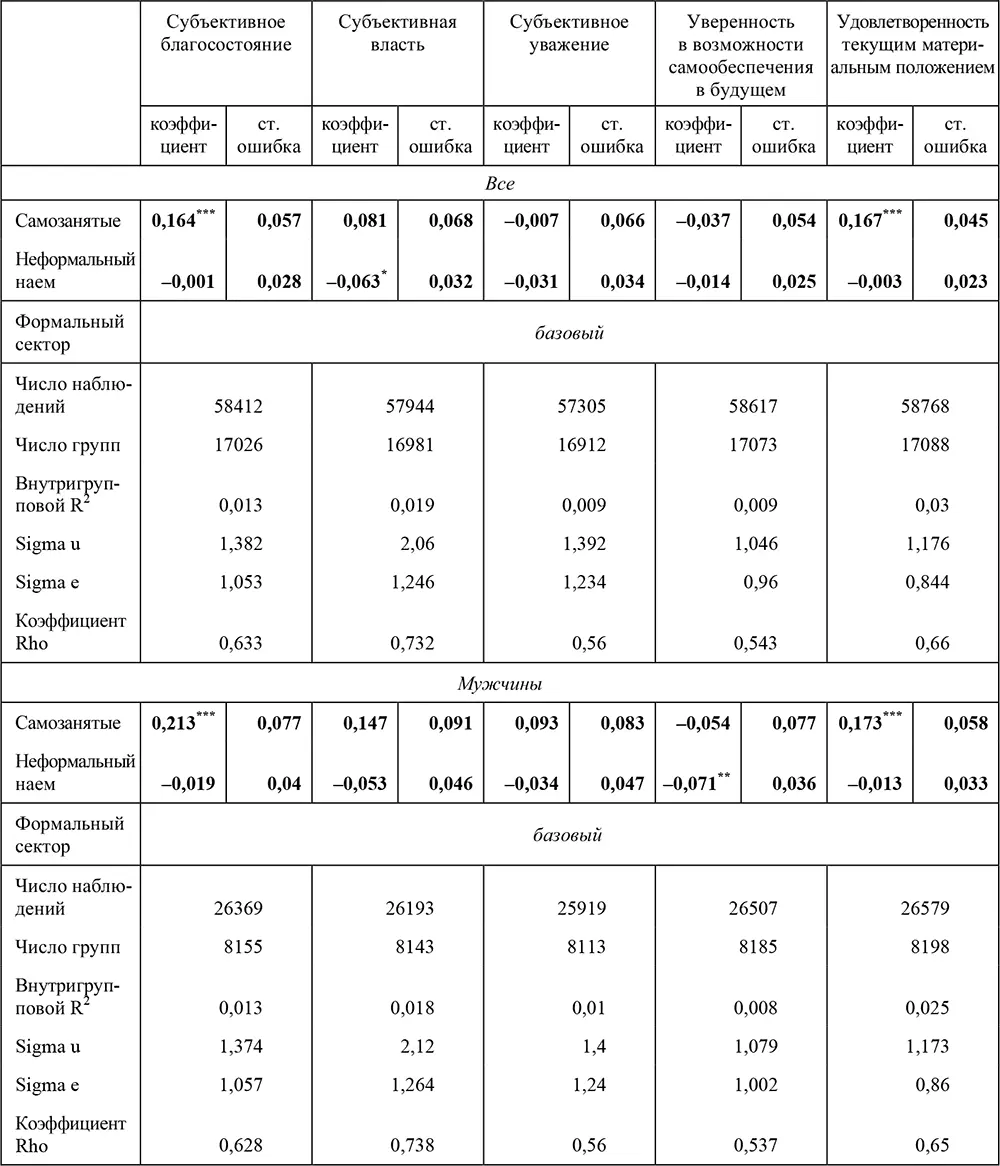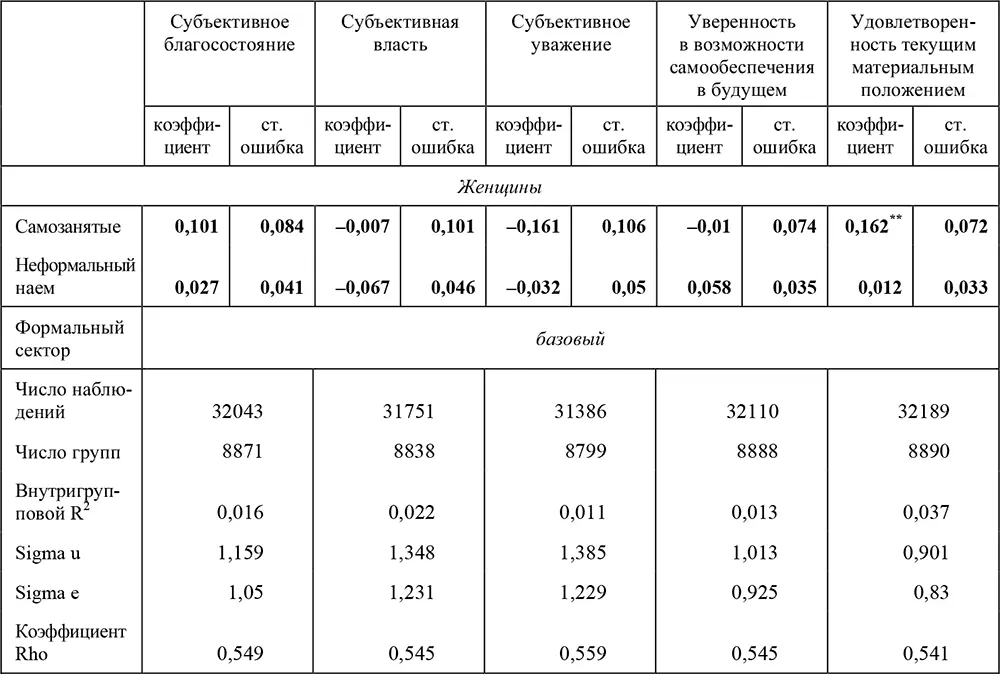

Примечание: контролируются уровень образования, возраст, семейное положение, тип населенного пункта, самооценка здоровья, число детей в домохозяйстве, логарифм душевого дохода, статус студента, статус пенсионера, федеральный округ, годовые дамми-переменные + отрасль занятости, специфический стаж, наличие второй работы, логарифм часов рабочей недели.
Аистов А. В., Ларин А. В., Леонова Л. А. Неформальная занятость и удовлетворенность жизнью: эмпирический анализ с учетом эндогенности // Прикладная эконометрика. 2012. № 2. С. 17–36.
Аистов А. В., Леонова Л. А. Удовлетворенность жизнью и работой, связь с незарегистрированной занятостью: препринт № WP15/2011/04. 2011.
Барсукова С. Ю. Формальное и неформальное трудоустройство: парадоксальное сходство на фоне очевидного различия // Социологические исследования. 2003. № 7. С. 3–15.
Дэвис К ., Мур У. Некоторые принципы стратификации // Социальная стратификация. Вып. 1. М., 1992. С. 160–177.
Дюркгейм Э. О разделении общественного труда // Западно-европейская социология XIX – начала ХХ веков. М., 1996.
Заславская Т. И ., Шабанова М. А. Неправовые трудовые практики и социальные трансформации в России // Социологические исследования. 2002. № 6. C. 3–17.
Синявская O . Неформальная занятость в современной России: измерение, масштаб и динамика / Научные проекты НИСП – IISP Working Papers. WP5/2005/01. 2005.
Adler N. E., Epel E., Castallazzo G., Ickovics J . Relationship of Subjective and Objective Social Status with Psychological and Physiological Functioning: Preliminary Data in Healthy White Women // Health Psychology. 2000. Vol. 19. № 6. P. 586–592.
Alwin D. F . Distributive Justice and Satisfaction with Material Well-being // American Sociological Review. 1987. Vol. 52. № 1. P. 83–95.
Beuran M., Kalugina E . Social Exclusion and the Informal Sector: The Case of Russia. Centre d’Economie de la Sorbonne, Université de Paris 1, CNRS, 2006.
Cassar L . Revisiting Informality: Evidence from Employment Characteristics and Job Satisfaction in Chile: Oxford Poverty and Human Development Initiative (OPHI) Working Papers. № 41. November 2010.
Centers R . The Psychology of Social Classes: A Study of Class Consciousness. Princeton: Princeton University Press, 1949.
Della Fave L. R . The Meek Shall not Inherit the Earth: Self-evaluation and the Legitimacy of Stratification // American Sociological Review. 1980. Vol. 45. № 6. Р. 955–971.
Falko P . Determinants of Income in Informal Self-employment: New Evidence from a Long African Panel / 6 thIZA/World Bank Conference: Employment and Development. 2012. (Online conference materials.)
Ferrer-i-Carbonell A., Gerxhani K . Financial Satisfaction and (In)formal Sector in a Transition Country // Social Indicators Research. 2011. Vol. 102. № 2. P. 315–331.
Gimpelson V. E., Kapeliushnikov R. I . Labor Market Adjustment: Is Russia Different?: препринт. WP3/2011/04. М.: НИУ ВШЭ, 2011.
Goldthorpe J., Lockwood D., Bechhofer F., Platt J. The Affluent Worker in the Class Structure. Cambridge, 1969.
Gross M . Educational Systems and Perceived Social Inequality: The Institutional Base for Class Formation // European Societies. 2003. Vol. 5. № 2. P. 193–225.
Grusky D. B., Sørensen J. B . Are There Big Social Classes? // Social Stratification: Class, Race, and Gender in Sociological Perspective. 2 nded. / ed. by D. B. Grusky. Boulder, Colo.: Westview, 2001. P. 183–194.
Jackman M. R . The Subjective Meaning of Social Class Identification in the United States // Public Opinion Quarterly. 1979. Vol. 4. № 43. P. 443–462.
Jackman M. R., Jackman R. W . An Interpretation of the Relation between Objective and Subjective Social Status // American Sociological Review. 1973. Vol. 38. P. 569–582.
Kelley J., Evans M. D. R . Subjective Social Location: Data from 21 Nations // International Journal of Public Opinion Research. 2004. Vol. 16. № 1. P. 3–38.
Kingston P. W . The Classless Society. Stanford: Stanford University Press, 2000.
Kluegel J. R., Smith E. R. Beliefs about Stratification // Annual Review of Sociology. 1981. Vol. 7. P. 29–56.
Laumann E. O., Senter R . Subjective Social Distance, Occupational Stratification, and Forms of Status and Class Consciousness: A Cross-national Replication and Extension // American Journal of Sociology. 1976. Vol. 81. № 6. P. 1304–1338.
Lindemann K . The Impact of Objective Characteristics on Subjective Social Position // Trames. 2007. № 11. P. 54–68.
Maloney W. F . Informality Revisited // World Development. 2004. Vol. 32. № 7. Р. 1159–1178.
Marshall G . Social Mobility // Oxford Concise Dictionary of Sociology / Marshall G. (ed.). Oxford, N.Y.: Oxford University Press, 1994.
Perry G. E., Maloney W. F., Arias O. S., Fajnzylber P., Mason A. D., Saavedra-Chanduvi J . Informality: Exit and Exclusion. The World Bank / Latin America and the Caribbean Studies Report. 2007.
Temkin B . Informal Self-employment in Developing Countries: Entrepreneurship or Survivalist Strategy? Some Implications for Public Policy // Analyses of Social Issues and Public Policy. 2009. Vol. 9. № 1.
Weber M . Class, Status and Party // Class, Status and Power / ed. by R. Bendix, S. M. Lipset. N.Y.: Free Press, 1966.
Weeden K., Grusky D . The Case for a New Class Map // American Journal of Sociology. 2005. Vol. 111. № 1. P. 141–212.
Wooldridge J. M . Econometric Analysis of Cross Section and Panel Data. Cambridge, MA; London, UK: The MIT Press, 2002.
Глава 11. Самозанятость в странах с переходной экономикой
На рынке труда помимо работающих по найму есть те, кто выступают одновременно и в качестве работодателя, и в качестве работника. Речь идет о самозанятых. Роль этой группы особенно велика в развивающихся странах, где ее численность приближается к численности наемных работающих, а нередко и превосходит. Однако и в развитых экономиках самозанятые составляют весомую долю от общей численности рабочей силы.
Читать дальше
Конец ознакомительного отрывка
Купить книгу














